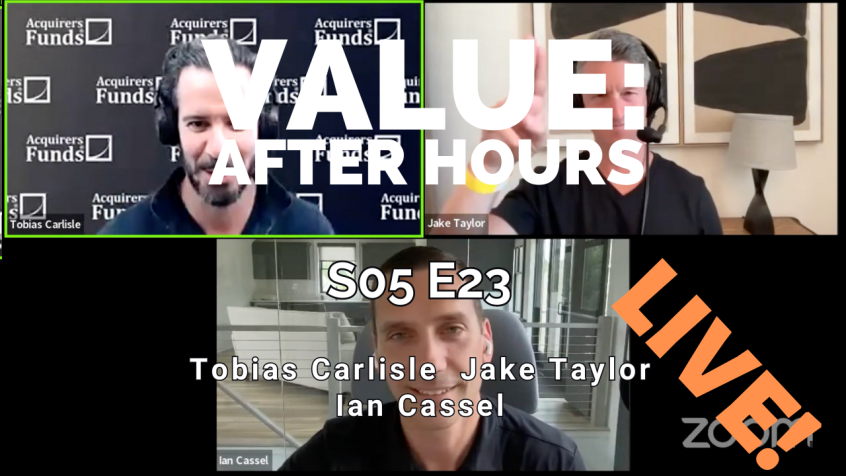During their latest episode of the VALUE: After Hours Podcast, Cassel, Taylor, and Carlisle discuss Find Companies With Growth & Survival Qualities. Here’s an excerpt from the episode:
Tobias: Let’s talk a little bit about– So, you’re small and micro, but you’re probably at the other end of the spectrum from me. I always think of you as being a little bit more growthy, even though I’m sure we overlap in some positions, because I hold quite a few and I tend to buy some of the better stuff in there too.
Ian: Yeah.
Jake: Ian, would you say it’s more growth or more quality, or is that a false dichotomy to you?
Ian: No, I would like to think that’s a fair assessment. I try to combine the two areas of growth and survival, because I think just focusing on growth, basically just a growth investor, it’s not right because you also need to survive, and survival is what maybe more of deep value or value focus on to a certain extent. So, I think the combination of those two equals quality. Growth and survival, both those sets of characteristics. And so, generally looking for companies that can sustain a high organic growth rate, one of one unique businesses, but also have a balance sheet that can endure that have a business that can hopefully grow through a recession. All those survival attributes combined with the growth is what I think makes for a really unique small business. It doesn’t mean that they’re less volatile than any other business or any other stock that’s small. So, to answer your question, Toby, yeah, we’re underperforming this year.
Tobias: SPY? What are you underperforming when you say you’re underperforming?
Ian: Basically, the IWC, which is the iShares micro-cap index. It’s what I have out there. Yeah. So, we’re underperforming that year to date. I even hate looking at benchmarks, because we zig where the market zags. Not only because of our portfolio construction, but because we have a couple of very bulky positions that can either make us look like heroes in bad times or look like losers in great times, depending on the quarter of the month. So, to give you guys an example, I think last year in June, we were down like 45 year to date. And then by the end of the year, we finished down 15. So, we slugged our way back.
Jake: Don’t call it a comeback.
Ian: Yeah, exactly.
Jake: [laughs]
Jake: So, you just live with the volatility. The larger your largest position becomes, the more your portfolio will follow that large position. We have a big bulky position. So, if you have a 30% or 40% position up or down 10%, that’s a plus or minus 3% or 4% on the portfolio. That’s like a 3% or 4% position going to zero or doubling. [crosstalk]
Tobias: And they’re small, so they tend to move around like that too. They can just trade-
Ian: They do.
Tobias: -wide. Yeah, it’s meaningless. Noisy.
Ian: It’s interesting right now the time period we’re in, because we’re having some– The Russell indexation is occurring. We’re right in the middle of that where they announce who the new additions and deletions are.
Jake: Oh, okay. Kicking. yeah.
Ian: Yeah. And so, that can influence some things. But it’s usually not as much or pronounced as what you think. It’s sort of like this voodoo black world of how do they actually acquire these shares.
Jake: Yeah.
Ian: There’s some companies that I follow, one of them I own– or two of them I own that were included, and then there’s a basket of other ones that I just follow. These are situations where the indexes literally probably have to buy 25% of that company’s float in a two-month period. All of those stocks, since they announced the addition, are down.
Jake: Really?
Ian: Yeah, there’s all this hearsay on micro-cap club or other boards too, like, where do they get these shares? The algo is accumulating or shorting this to that, and how do they block off this stock? It’s all basically a big distraction, to be honest with you. But it is an interesting time period because of some of this volatility you’re seeing because of the Russell inclusions.
Tobias: Do you see the volume go through? Does sufficient volume go through for them to have amassed the position that they do, or you don’t even see the volume go through?
Ian: You normally see it the day of inclusion, which I believe is June, was it 24th, 27th, somebody’s listening to this probably knows. It’s one of those dates.
Jake: Mark your calendars.
Ian: Yeah. Usually, what you see is in the last hour of trading, you’ll just see volume, and then some block trades go off in their securities, and that’s when you’re wondering, “Well, how did that happen or who’s the other side of this?”
Tobias: Like, that way it has them somewhere.
Ian: Yeah, some people believe they start actually acquiring shares months in advance, but it still doesn’t make sense. So, it’s a fun thing to just watch and try to theorize on how to do this.
Jake: Put your tinfoil hat on and then–
Ian: Exactly. Yeah, exactly.
[laughter]You can find out more about the VALUE: After Hours Podcast here – VALUE: After Hours Podcast. You can also listen to the podcast on your favorite podcast platforms here:
For all the latest news and podcasts, join our free newsletter here.
Don’t forget to check out our FREE Large Cap 1000 – Stock Screener, here at The Acquirer’s Multiple:



